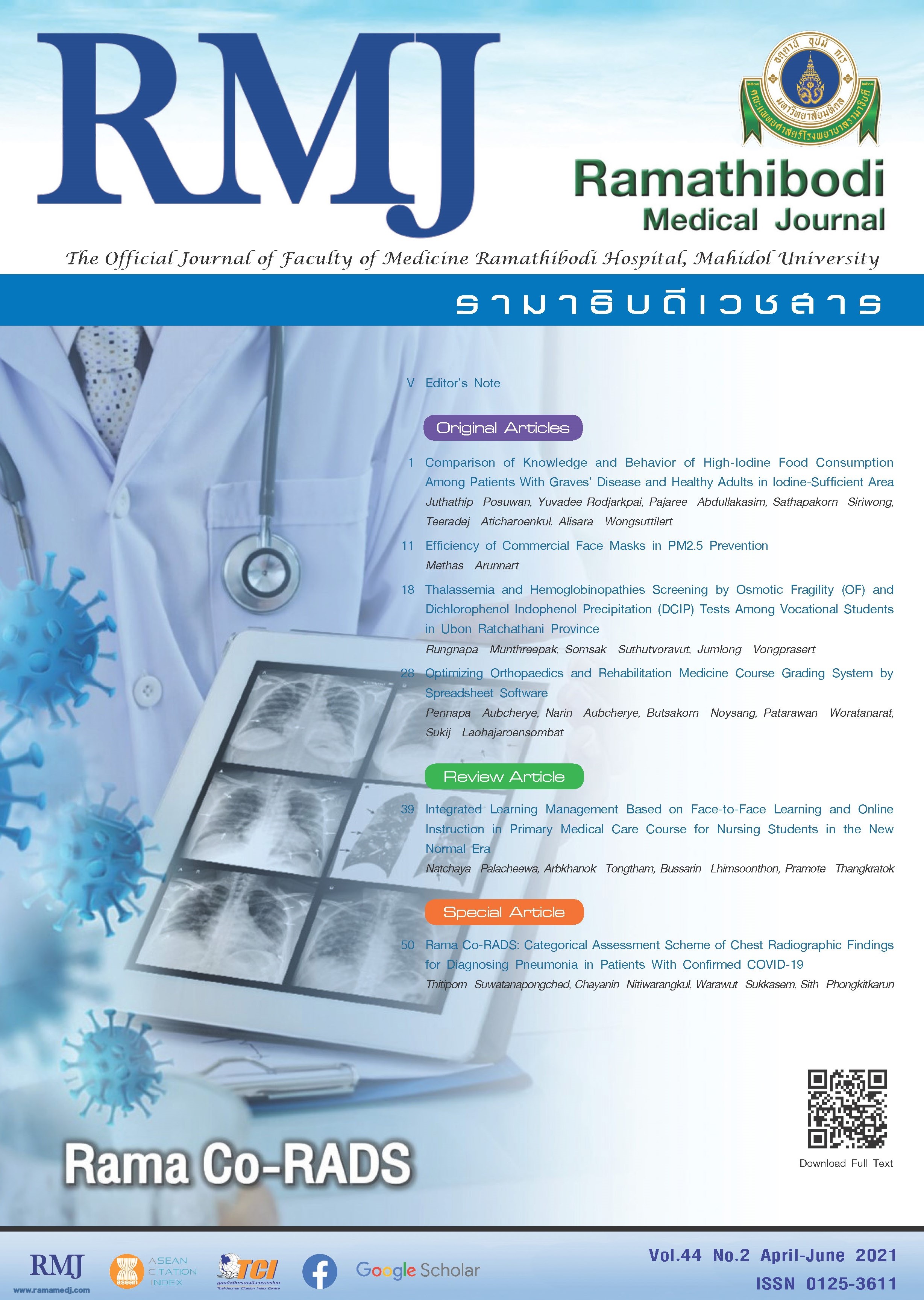Integrated Learning Management Based on Face-to-Face Learning and Online Instruction in Primary Medical Care Course for Nursing Students in the New Normal Era
DOI:
https://doi.org/10.33165/rmj.2021.44.2.246926Keywords:
Blended learning, New normal era, Nursing studentsAbstract
Blended learning refers to the model of integration between face-to-face learning and online instruction. This model used in coronavirus disease 2019 (COVID-19) pandemic, essential for prevention and control the emerging infectious disease transmission, and enhanced achievement of expected learning outcomes among nursing students. This article aimed to present a blended instruction based on asynchronous and synchronous online learning with face-to-face approach in primary medical care course for nursing students in the new normal era. The instructional design based on the 5 components of the ADDIE model including 1) analysis, 2) designs, 3) development, 4) implementation, and 5) evaluation. The conceptual framework for evaluating blended learning outcomes including 1) learners’ satisfaction, 2) students’ engagement, and 3) course outcomes. It was found that the learners’ satisfaction on blended learning were at high level. Blended learning performs a pivotal role in supporting nursing students’ engagement. All nursing students gained higher scores than the pass criteria. This article determined on improving nursing education through blended learning and extended novel issues for further research and development.
References
World Health Organization. Coronavirus disease (COVID-19) weekly epidemiological update and weekly operational update. Geneva: World Health Organization (WHO); 2020. https://www.who.int/emergencies/diseases/novel-coronavirus-2019/situation-reports. Accessed October 28, 2020.
World Health Organization. Coronavirus disease (COVID-19) advice for the public. Geneva: World Health Organization (WHO); 2020. https://www.who.int/emergencies/diseases/novel-coronavirus-2019/advice-for-public. Accessed October 28, 2020.
Graham CR. Emerging practice and Research in Blended Learning. In: Moore MG, ed. Handbook of Distance Education. 3rd ed. New York, NY: Routledge; 2013:333-350.
Dziuban C, Graham CR, Moskal PD, Norberg A, Sicilia N. Blended learning: the new normal and emerging technologies. Int J Educ Technol High Educ. 2018;15:3. doi:10.1186/s41239-017-0087-5.
Garrison DR, Kanuka H. Blended learning: uncovering its transformative potential in higher education. Internet and Higher Education, 2004;7(2):95-105. doi:10.1016/j.iheduc.2004.02.001.
Graham CR. Blended Learning Systems: Definition, Current Trends, and Future Directions. In: Bonk CJ, Graham CR, eds. Handbook of Blended Learning: Global Perspectives, Local Designs. San Francisco, CA: Pfeiffer; 2006:3-21.
Parsad B, Lewis L. Distance Education at Degree-Granting Postsecondary Institutions: 2006–07. Washington, DC: National Center for Education Statistics, Institute of Education Sciences, U.S. Department of Education; 2008. https://nces.ed.gov/pubs2009/2009044.pdf. Accessed October 28, 2020.
Boelens R, Van Laer S, De Wever B, Elen J. Blended learning in adult education: towards a definition of blended learning. Adult Learners Online. http://www.iwt-alo.be/wp-content/uploads/2015/08/01-Project-report-Blended-learning-in-adult-education-towards-a-definition-of-blended-learning.pdf. Published June 15, 2015. Accessed October 28, 2020.
Driscoll M. Blended learning: let's get beyond the hype. IBM Global Services; 2002. https://www-07.ibm.com/services/pdf/blended_learning.pdf. Accessed October 28, 2020.
Leidl DM, Ritchie L, Moslemi N. Blended learning in undergraduate nursing education – a scoping review. Nurse Educ Today. 2020;86:104318. doi:10.1016/j.nedt.2019.104318.
Sáiz-Manzanares MC, Escolar-Llamazares MC, Arnaiz González Á. Effectiveness of blended learning in nursing education. Int J Environ Res Public Health. 2020;17(5):1589. doi:10.3390/ijerph17051589.
Sweeney MR, Kirwan A, Kelly M, et al. Transition to blended learning: experiences from the first year of our blended learning Bachelor of Nursing Studies programme. Contemp Nurse. 2016;52(5):612-624. doi:10.1080/10376178.2016.1197781.
Nantsupawat A, Nantsupawat R. Satisfaction and outcomes of the teaching styles with blended learning in a nursing leadership and management course, Faculty of Nursing, Chiang Mai University. Nursing Journal. 2013;40(suppl):47-60.
Lertwittayakul T. The effectiveness of blended instructional model enhancing outcome learning in ethics & professional law subject for nursing students. CAS Journal. 2019;9:125-132.
Sinthukot P, Monthawee S. Effect of a blended learning instruction on learning achievement in child and adolescent nursing 2 subject of the third year nursing students of The Royal Thai Navy College of Nursing. Royal Thai Navy Medical Journal. 2020;47(1):158-171.
Thaewpia S, Potchana R, Intaraphet S. The impact of blended learning achievement, satisfaction, and self-directed learning in nursing students. NSH. 2019;42(4):121-131.
Rueangsawat S, Saetew P, Choome P. The effect of blended learning management on 21st century learning skills for nursing students, Boromarajonani College of Nursing, SuratThani. J Royal Thai Army Nurses. 2020;21(1):235-244.
Xuto P, Niyomkar S, Yothayai C. The effect of using blended learning to improve nursing students’ information technology competency as a way to support training for fourth year nursing student, Faculty of Nursing, Chiang Mai University. J Nurs Educ. 2014;7(4):156-167.
Kruse K. Introduction to instructional design and the ADDIE Model. Academic Press 2002. https://portal.ct.gov/-/media/CTDN/TtT2015/ttt2015module5IntroInstDesignADDIEpdf.pdf. Accessed October 28, 2020.
Bowyer J, Chambers L. Evaluating blended learning: Bringing the elements together. Research Matters: A Cambridge Assessment publication. 2017;23:17-26. https://www.cambridgeassessment.org.uk/Images/381638-research-matters-23-spring-2017.pdf. Accessed October 28, 2020.

















